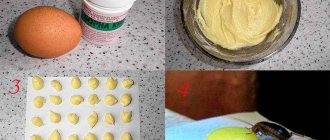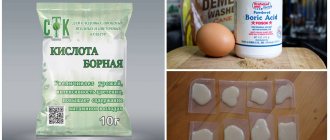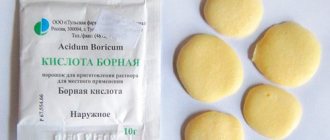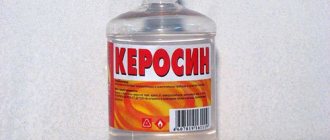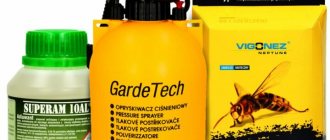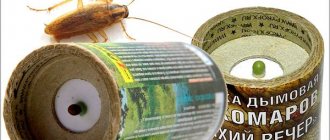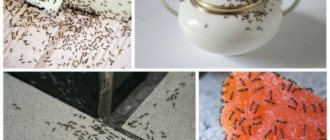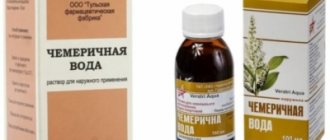Safety precautions when using boric acid poisons
Despite the fact that the drug is called “acid,” it has nothing in common with the usual understanding of this word.
It is harmless to the skin and does not leave any burns. The chemical is not considered particularly dangerous for children or pets. Previously, it was even used as an antiseptic. But it often caused allergies, and it was soon replaced by more suitable means.
If we compare it with other poisons for baiting cockroaches, we should also say about its safety for the human body. However, contact with boric acid is strictly contraindicated for children under three years of age. If it happens that a pet accidentally eats the bait, then nothing fatal will happen to it, but it is better not to allow this to happen.
Pregnant and lactating women, people with kidney failure and inflammatory skin diseases are also better off not interacting with this drug.
If the incident cannot be avoided, the person may experience symptoms such as nausea, vomiting, skin rashes and headaches.
Boric acid poisoning of pets
When baiting cockroaches and other insects found indoors, boric acid mixed with edible bait (for example, egg yolk or potato) is often used. Of course, it is necessary to isolate your pets from poison. Unfortunately, the carelessness of the owners, coupled with the curiosity and gluttony of pets, can lead to your pet swallowing poison. This is dangerous for animals and can lead to death.
Symptoms depend on the concentration of the substance ingested. At low doses, puppies or kittens and older animals are affected. When a large amount of toxin is ingested, dyspeptic disorders, skin reactions, and convulsions occur. The animal requires emergency medical attention from a veterinarian. At the clinic, gastric lavage will be performed (the procedure is effective in the first 30 minutes after swallowing the acid), injections with special medications will probably be given, saline will be instilled, and tests will also be taken to monitor kidney parameters.
The effect of boric acid on an animal depends on their size. For small cats the danger is greater. For large dogs - less; poisoning may not occur at low concentrations of the toxin.
When choosing a recipe for cockroaches with boric acid, what should you consider?
Any cockroach remedy with boric acid you choose will be 100% safe for animals in the house and children. But there is one “But”. The antiseptic substance has an allergic effect. More precisely, its components can cause skin allergies upon contact in children and people with sensitive skin. That is why cockroach poison with boric acid and egg, the recipe for which has been known for several 10 years, is the safest way to poison insects. If you have sensitive skin, wear gloves and work in them.
Powder and boron balls against cockroaches do not cause:
- Skin irritation;
- Burns (even sensitive skin does not suffer);
- Irritation of the mucous membranes of the lungs and oral cavity;
- Poisoning in animals and people.
Cheap cockroach poison with boric acid - 100% safe. Do not use pure powder in the house if there are children or people with allergies.
How to use boric acid to kill fleas?
Using boric acid on its own or as a homemade mixture can cause problems.
The problem with homemade pesticide mixtures is that there are no directions on how to use them (where to apply them, how much to use, etc. This can lead to someone possibly using much more than than necessary (increases the likelihood of unintentional overexposure), or applies it somewhere that may be more risky for people or animals.
Industrial preparations with boric acid that undergo a risk assessment procedure for humans and animals. They are applied to floors and carpets.
Boric acid should not be used outdoors because if the substance gets wet, it may no longer be an effective flea treatment.
“Because it's a pesticide, it has to kill something. All pesticides have some level of toxicity. This is why following the directions for veterinary registered boric acid preparations is essential to ensure the safety of both pets and people. Boric acid should never be applied directly to your pet.
What is boric acid?
In its pure form, boric acid is a white crystalline powder. In medicine it is used in the form of a weak alcohol or aqueous solution.
The antiseptic properties of boric acid were discovered by the French chemist Jean Baptiste Dumas. After that, it began to be actively used in medicine instead of the previously used smelly carbolic acid: boric acid did not leave marks on the sheets in hospital wards and did not smell. However, later more effective antiseptics were discovered. Compare: the usual concentration of boric acid for antimicrobial treatment is 2 or 3%, and, for example, chlorhexidine - 0.05%. Therefore, recently boric acid is more often used in home medicine cabinets than in medical institutions.
The substance has a third class of hazard, therefore it must be stored in special packaging, out of reach. Boric acid is used:
- In medicine to relieve inflammation of the skin, eye sclera, and ear canal.
- As an antiseptic for healing wounds and bedsores; in low concentrations it can be used as a solution for contact lenses.
- As a poison against insects indoors.
- In agriculture as a fertilizer to accelerate plant growth and to kill pests.
- In industry in glass production (borosilicate glass is resistant to sudden temperature changes), in the production of enamels, some detergents and cosmetics.
Boric acid and its characteristics
Before using this drug to kill pests, you need to understand what it is. Boric acid is a colorless powder, somewhat similar to flakes. The powder can hardly be dissolved in water, and it is absolutely tasteless and odorless. Relative safety allows people to actively use it for their needs.
Acid is sold in any pharmacy, packaged in 10 gram bags. Due to the lack of odor, the drug can be discreetly placed in the bait without scaring off the Prussians. This is the method of pest control.
Let us next consider what recipes exist with boric acid for cockroaches.
General information about boric acid – Acidum boricum
Boric acid is colorless, shiny, slightly greasy crystals to the touch.
, soluble in water (1:25). Available in powder.
In veterinary medicine, boric acid acts antimicrobially against gram-positive and gram-negative microorganisms. Externally used for washing the mucous membranes of the eyes, nose, and oral cavity of animals (dogs, cats, pigs, horses, cattle, small cattle) in the form of a 2-4% solution; in the form of ointments (5-10%) and powders for inflammatory skin diseases.
Boric acid, potatoes and yolk
A very effective remedy for cockroaches. Potatoes, yolk, boric acid - its main components - simple ingredients, found in every home.
We suggest you familiarize yourself with How to remove paint from clothes
First you need to boil one egg and potatoes. Then peel the finished products and grind them into puree. Equal proportions of boric acid and yolk should be observed. Mix the resulting mass with a tablespoon of boric acid, and then form into balls. Place the finished bait in the corners and do not forget about a dry surface throughout the kitchen.
How to poison cockroaches with boric acid and eggs?
Insects love the “dump” and dirty corners, as well as moisture and darkness. This means that the apartment or house needs to be prepared for the grass of the Prussians. Before using yolk and boric acid against cockroaches, you must:
- Wash the apartment behind the furniture, under the baseboards, thoroughly vacuum the parquet floors, cracks, and furniture. Egg yolk with boric acid will not help against cockroaches if the insects have a choice in food.
- Prepare in the evening (right before the laying out procedure) balls with boric acid and egg against cockroaches, the recipe for which should be chosen in advance and all the ingredients prepared.
- Wipe dry taps, tiles in the kitchen and bathroom.
- Close all taps tightly. The dripping ones need to be fixed. Remember that cockroaches love moisture - boric acid in recipes will simply lose its concentration if it is diluted with water.
- Hide all wet hygiene and cleaning products overnight.
- Moving all indoor flowers to another room is the best source of moisture. If liquid boric acid is used against cockroaches, pay special attention to its concentration. Do not omit the dilution, otherwise there will be no effect.
Despite the fact that the most effective remedy for cockroaches is boric acid, you will not be able to get rid of cockroaches unless you follow all the rules of baiting. Poisonous treats are placed in all dark places where garbage has been swept away during cleaning. And also use boron powder against cockroaches in other rooms to prevent insects from escaping from the kitchen or bathroom into the bedroom or living room.
The bullying process is not quick. Decomposed boric acid cockroach poison should be removed no earlier than after 1.5-2 months. And in apartments on the first and last floors it should be used constantly. It happens that Prussians run away from their neighbors. Then it makes sense to tell them how to get rid of cockroaches with boric acid and recommend a recipe. But also take preventive measures yourself. By applying comprehensive measures, it is easy to get rid of Prussians forever.
Tips for folk remedies for cockroaches
Experts recommend using an integrated approach to the destruction of mustachioed pests. For example, combine treatment with aromatic oils with the installation of traps.
In apartment buildings, it is best to first agree with neighbors about joint processing. Otherwise, cockroaches may go to them. And after a while they will return to you, after the neighbors have carried out their processing. Thus, they will “roam” from apartment to apartment and it will be almost impossible to remove them.
Instead of vinegar, you can use wormwood, although its smell is weaker than that of vinegar. Therefore, the effectiveness will be lower, but you will be able to get rid of headaches and normalize blood pressure.
Cockroaches are creatures that are predominantly nocturnal and they don’t really “like” light. Therefore, leaving the lights on in the kitchen and bathroom at night will force them to eventually leave the “inhospitable” apartment. True, the method is effective only with a small number of “guests”.
How does boric acid poisoning occur?
Boric acid intoxication is rarely diagnosed, but can lead to unpleasant consequences. There are two methods of poisoning: ingestion or contact of the epidermis with a large volume of the substance.
Poisoning is often diagnosed in a child. The reasons are the use of boric acid left unattended, and the treatment of the mother's nipples with this substance.
When it enters the body, the chemical compound accumulates in the intestines and gall bladder. The removal of boric acid occurs over a long period of time.
Poisoning with a large volume of boric acid can be fatal. The critical dosage depends on the patient's condition. The maximum consumption is considered to be up to forty grams of the drug in adults and up to five grams in children.
Poisoning by vapors occurs very rarely; boric acid poisoning through the epidermis can be caused by prolonged excessive application of the product to the skin.
How does poisoning occur?
Boric acid, when it enters the body, is stable, that is, a significant part of it will be released unchanged through the kidneys . However, some portion of the substance still breaks down, causing irreparable harm.
Upon penetration, the acid is distributed throughout the tissues, causing damage to the liver, kidneys, and spleen. Kidney and liver failure occurs, organs lose their function. During autopsies of deceased patients, areas of necrosis are observed in the organs. When it enters the blood, boric acid penetrates the blood-brain barrier into the brain, causing swelling and necrosis of neurons. Epileptic convulsions appear. All this can lead to the death of a person or animal.
With prolonged exposure to boric acid on the human body (for example, through the skin), the hematopoietic function suffers. This is determined in a general clinical blood test. The number of lymphocytes increases as the body tries to fight the foreign agent. The number of red blood cells, the cells responsible for oxygen delivery, decreases. Disturbances within the body cause external changes: itching, rashes, peeling appear on the skin, and hair loss.
If poisoning occurs during pregnancy, then in the case of a high concentration of the substance, a miscarriage is likely; in the case of a low concentration, congenital deformities, developmental disorders, and organ defects of the newborn are possible.
On February 2, 1987, the USSR Ministry of Health made a decision: “...to prohibit the use of boric acid as an antiseptic in infants, as well as in women during pregnancy and lactation due to its low activity and high toxicity.”
There are two ways of poisoning with a substance:
- Orally . Children may find a bottle left unattended and drain it, not understanding what will happen if they drink boric acid. The substance is odorless and tasteless, so the toxin is likely to be ingested due to the lack of an unpleasant aftertaste.
- Through the skin or by inhalation . The second option occurs rarely - in industrial production when the worker does not have personal protective equipment (respiratory mask). The substance enters the body gradually when using solutions that contain boric acid. If a person has injuries, cracks, eczema, burns on the skin, penetration accelerates, the substance enters the blood faster.
The lethal dose of boric acid for an adult is 5-20 grams . The range depends on the functioning of the kidneys - the better this organ functions, the easier intoxication will be tolerated. Children (especially newborns) have underdeveloped renal function, so for them even a lower dose can be lethal.
What other recipes can I use?
Let's consider alternative ways to make poison for cockroaches from boric acid and:
It is necessary to take sugar in equal proportions (you can grind regular sugar into sand) and a toxic substance. Move components carefully. Water is added to the resulting mass so that the dough can be kneaded. Next, we roll balls of boric acid against cockroaches on sugar and water.
- Powdered sugar, starch and vanilla.
You need to take 60 grams. starch and move it with 60 gr. powdered sugar. Add 25 grams to the resulting mass. vanillin. Add 200 gr. boric acid against cockroaches - the recipe is designed for treating a large area. After thorough mixing (uniformity is very important), gradually pour water into the mixture.
- Potatoes and boiled eggs.
In the first recipe, boric acid was mixed with cockroach yolk; in this recipe you need to boil potatoes and an egg (whole). After preparing the ingredients, you need to peel and peel them, then grind them into a thick puree. Add a cockroach repellent to the resulting mass - boric acid in an amount of 200-250 g.
In principle, any food can be added to the poisonous powder. But for a housewife, what is ultimately important is the cost and ease of preparing the medicine for cockroaches, and boric acid and an egg, as we described above how to prepare them, is the fastest and most affordable recipe.
Use and application
To lure insects to odorless, tasteless acid, you need to prepare special baits that cockroaches will definitely want to try. To attract dangerous pests to the bait, the drug is usually mixed with various products and be sure to block cockroaches’ access to water. Over time, cockroaches adapt to boric acid and it will no longer affect them. In such a situation, the pest control agent will need to be replaced. You can remove nasty aliens in the following ways:
- Mix two bags of boric acid thoroughly with boiled yolk, add a little water. Make small peas and place them in places where insects often run.
- Prepare mashed potatoes from boiled potatoes, into which pour one sachet of boric acid. Roll small peas and place in problem areas.
- mix wheat flour, boric acid, granulated sugar, water to form a dough-like mass. Make small cakes and place them in areas where cockroaches move.
- Mix the yolk from a raw egg with flour, add a bag of powder, make balls.
- pour boric acid, sugar, starch, vanillin into the water, mix thoroughly until a sticky consistency forms.
- Add boric acid to a saucer with clean water and place it in areas where cockroaches move.
- Sprinkle boric acid in areas where cockroaches were found.
The acid will help remove cockroaches if their colony has not yet reached enormous size.
If the area is heavily infested, it will not be possible to obtain the desired results, since a large number of insects requires the use of special equipment and insecticides.
Treatment of cat poisoning
If you suspect poisoning in your pet, the owner of the animal should immediately contact a veterinary clinic. Some poisons are so strong that the animal can die within a few hours after poisoning. It is extremely important to indicate to the doctor what could have caused the intoxication.
We suggest you familiarize yourself with How to remove wax from fabric - how to remove a stain from a candle, how to remove it, how to remove drops from jeans, leather, fur and suede
First of all, detox is prescribed - diet and treatment. If toxic substances penetrate through the skin or mucous membranes, there is no need to rinse the digestive tract.
The first aid for treating cats with food poisoning is gastric lavage to eliminate the toxic substance from the digestive system. It is not recommended to carry out this manipulation at home, as this can cause gastric rupture.
It is forbidden to give antiemetic medications to cats with food poisoning (the body must cleanse itself of toxins). At first, feeding a cat that is poisoned is prohibited; you can only give clean, warm water. You can add a little salt to warm water and pour it into the sick animal’s mouth.
It is important to ensure that your cat does not become dehydrated during diarrhea and vomiting. To do this, it is important to administer special medications to the patient - saline solutions. The amount of saline solutions administered should not be one-time or large; it is advisable to give a little at a time.
Toxic substances that enter the body must be bound. For these purposes, activated carbon is used, taking into account the weight and age of the sick animal. In addition, it is necessary to use enterosorbents such as Polysorb or Smecta.
A severely weakened animal requires a different approach - the administration of cardiac medications, as well as medications that stimulate the functioning of the respiratory center. In addition to enterosorbents, diuretics help remove toxins from the body as quickly as possible.
Intoxication of a cat’s body with non-food products requires the use of a different treatment regimen. When an animal is bitten by poisonous insects, cold must be applied to the affected area. This contributes to the immediate narrowing of small and large blood vessels, and toxic substances will spread more slowly to other tissues of the body.
If a pet is poisoned by phosphorus-containing substances, it is necessary to immediately administer a specific antidote - an antidote (dipyridoxime) and atropine. The dose of the drug must be prescribed by a veterinarian, otherwise an overdose may occur and the animal will die.
Contact with alkaline compounds on the skin involves the application of acidic substances (acetic or citric acid). If acidic substances come into contact with the skin, apply alkaline substances - baking soda or soap solution.
Cat intoxication with heavy metal salts can be treated by administering sodium sulfate.
Therapeutic measures for animal poisoning with isoniazides include several main points:
- cleansing the gastrointestinal tract by inducing vomiting (warm saline solutions are used for this);
- introduction of laxative drugs into the oral cavity;
- the administration of enterosorbents (for example, Enterosgel) helps prevent further spread of poisons throughout the body;
- introduction of antidotes - vitamin B6.
If an animal is intoxicated with zoocoumarins (poisons used to kill rodents), it is necessary to act immediately, without delay. The cat is artificially induced to gag and given a laxative enema. The drug to eliminate the effect of warfarin is vitamin K. In addition, medications containing iron are prescribed.
The pet should be under constant supervision of a specialist, since even a slight improvement in body parameters can be deceptive.
Some nuances of preparing for the process
The poisonous substance is part of boric alcohol, so many people buy alcohol in the pharmacy if they don’t have the powder. Boric alcohol is not effective against cockroaches and newly hatched cockroaches, since it repels them due to its sharp and specific smell. If you are fighting cockroaches in an apartment using boric acid, then you need to buy sand powder in bags.
At the pharmacy you will need to buy 1-2 sachets of the poisonous substance. The volume of poison depends on the amount of poison that needs to be prepared. To treat a 3-room apartment, 3-4 packets of boric acid powder is enough - a smaller amount will help against cockroaches, but the poison needs to be spread out in as many dark places as possible. Therefore, it is better to buy a bag. Now all that remains is to give a recipe for cockroaches with boric acid and yolk, and tell you the rules for placing the balls.
The effect of boric acid on parasites
Boric acid (tasteless and odorless white powder) is a powerful antiseptic that can be purchased at any pharmacy. With its help you can not only disinfect the surface. The powder is used as a poison to get rid of ants in a residential area.
READ ALSO: How to permanently remove pests and get rid of ants in the house: effective chemicals, proven folk remedies, traps and ultrasonic repellers
How boric acid will help get rid of insects:
- When an insect eats food bait mixed with boric acid, gradual damage to its nervous system begins, which leads to paralysis and then death. Sometimes several days pass from the moment of consuming the poison to death.
- It is important that the death of an ant when consuming boric acid does not occur instantly; it manages to return to the nest. In addition, the ants take the poisoned food with them into the anthill in order to feed the queen.
- In the nest, the poisonous delicacy brought, and subsequently the corpses of dead insects with poison, are devoured by “relatives”, thus starting a chain reaction of destruction of insects harmful to the home.
- Additionally, boric acid deprives male ants of the ability to reproduce and the female ant to produce offspring.
- The process of removing ant colonies using boric acid is not quick, usually requiring at least a month. However, this is the only way to effectively clean a room of all insects.
The mechanism for killing insects with boric acid is the most effective, since ants reproduce in an anthill nest, the location of which is often inaccessible to the owners. Since ants reproduce very quickly, destroying only available individuals often does not produce results. Some of the ants die, but in the meantime the total number of parasites only grows.
The gradual destruction of insects in their own nest, combined with gradual sterilization, turns out to be very effective. Minced meat, chicken egg yolks and sweet ingredients - honey, sugar, jam (ants especially love sweets) are used as food bait for mixing with poison.
READ ALSO: DRILLING WELLS FOR WATER
First aid and treatment of intoxication
If signs of poisoning appear, it is necessary to quickly provide the victim with the necessary first aid.
- First of all, in case of poisoning, call a doctor,
- If boric acid gets on the mucous membranes or skin, rinse with cool water.
- It is necessary to cleanse the stomach of toxic substances. Rinse with water. The procedure is repeated until the boric acid is completely released. It is prohibited to use potassium permanganate solution for rinsing to avoid burns to the esophagus.
- It is not recommended to stop spontaneous vomiting or diarrhea in case of poisoning; the body independently tries to get rid of toxins.
- It is not recommended to use sorbents; they will not help in such a situation due to the fact that boric acid does not come into contact with these medications.
- The use of saline laxatives is acceptable.
- Taking special medications or drinking large amounts of water will help you avoid dehydration.
- The patient is kept at rest and transferred to doctors for further treatment.
Intoxication therapy continues in a medical facility. The necessary diagnostics are carried out and suitable methods of therapy are selected.
- Cleansing the stomach using a probe,
- Using saline laxatives
- Blood transfusion,
- Hemodialysis,
- Forced diuresis,
- Administration of intravenous medicinal solutions,
- In case of serious poisoning, it is possible to administer plasma,
- If necessary, resuscitation measures are carried out.
We suggest you read How to quickly defrost whole pink salmon
There is no specific antidote to boric acid.
Use in the fight against acne
Orthoboric acid is an excellent helper in the fight against acne. Moreover, the price for this product is minimal. But before using this acid for cosmetic purposes, you need to consult a specialist and make sure that there is no sensitivity to the components of the solution, so that an allergic reaction does not occur in the future.
To treat acne, it is necessary to wipe the affected areas of the skin with a small amount of orthoboric acid using a cotton pad. You can also apply acid precisely using a cotton swab. This product is excellent at helping to cope with unwanted acne, as it slightly dries the skin, exhibits bactericidal properties and relieves severe inflammation.
Causes of cat poisoning
There are many causes of poisoning in cats. In veterinary medicine, there are several main ways for toxic substances to enter the animal’s body. The basic ones are:
- Foodborne - ingestion of a toxic substance through food or poisoned water. Signs of toxins entering the body can vary. It depends on the type of poison - phosphides, zoocoumarins, drugs. The main symptom is stool upset and eruption of gastric contents.
- Airborne – penetration of toxins through the respiratory tract. Toxins in the form of aerosol, vapor and gas enter the alveoli and immediately into the systemic bloodstream, spreading to all organs and systems of the body.
- Through the mucous membranes of the oral cavity and skin. This type of intoxication of the body occurs most often with the wrong dosage of medicinal substances intended to kill fleas, ticks and other skin parasites. It happens that a pet gets poisoned by household chemicals when it comes into contact with various detergents.
- Subcutaneous, intravenous or intramuscular type of poisoning. The cat owner does not always clearly know the correct dosage of the drug and independently prescribes treatment for his animal. In such cases, it is important to contact a veterinarian to avoid serious poisoning.
Dangerous substances include:
- Sodium chlorate – herbicides and fungicides;
- Preparations for baiting insects and mollusks. Plant-based insecticides are relatively safe for domestic cats. But there are a number of moluscids and insecticides of synthetic origin that cause real harm to the body. These insecticides include preparations used for flea and tick collars. An overdose of organophosphates is possible, which ultimately leads to intoxication of the body.
- Another type of poison dangerous for cats is rotenticides. The most common poison intended for baiting rodents is warfarin (zoocoumarin). This type of toxin provokes a violation of blood clotting factors. Zoocoumarins cause the animal to die from extensive hemorrhages. Strychnine is dangerous for domestic and stray cats. When this poison enters the body, it provokes severe convulsions and convulsive conditions.
- Chemicals (household chemicals). Various alkaline solutions and acids used in everyday life for cleaning and treating premises. A cat can get its paws into chemicals, get dirty and be poisoned.
- Medicines. Medications, especially aspirin and paracetamol, can harm the animal's body.
- Poisoning with salts of heavy metals. Arsenic, mercury and lead are especially dangerous.
- Toxic substances in feed. Low-quality food products can be contaminated with staphylococcus, botulinum toxin, salmonellosis and other pathogenic microorganisms that release toxins during their life processes and poison the cat’s body into which they enter. In addition, intoxication can occur when pathogenic fungal microorganisms are ingested with food.
- Plant toxins and insect poisons. Intoxication of the body can occur when eating plants such as azalea, dieffenbachia, ivy and philodendron. In addition to plants, insects that bite pets also pose a danger. Insect toxins are not always fatal to cats, but can cause a specific allergic reaction in the body.
